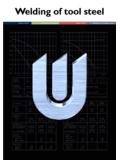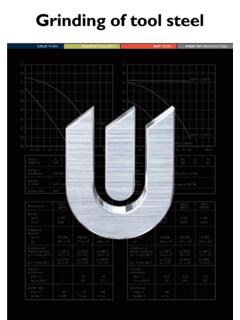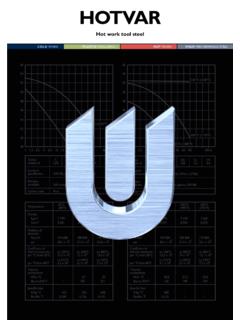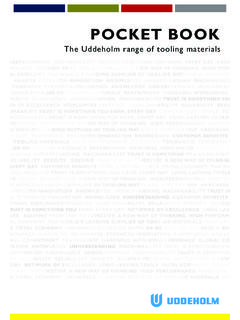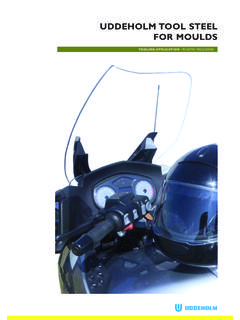Transcription of STAVAX ESR - Bohler Uddeholm
1 STAVAX ESR. Stainless mould steel STAVAX ESR. This information is based on our present state of knowledge and is intended to provide general notes on our products and their uses. It should not therefore be construed as a warranty of specific properties of the products described or a warranty for fitness for a particular purpose. 2. STAVAX ESR. General Applications STAVAX ESR is a premium grade stainless tool steel Whilst STAVAX ESR is recommended for all types of with the following properties: moulding tools, its special properties make it good corrosion resistance particularly suitable for moulds with the following good polishability demands: good wear resistance Corrosion/staining resistance, for mould- good machinability ing of corrosive materials, PVC, acetates, and good stability in hardening. for moulds subjected to humid working/storage conditions. The combination of these properties gives a steel with outstanding production performance.
2 The Wear resistance, for moulding abrasive/. practical benefits of good corrosion resistance filled materials, including injection-moulded in a plastics mould can be summarized as follows: thermosetting grades. STAVAX ESR is recom- mended for moulds with long production runs, Lower mould maintenance costs. disposable cutlery and containers. The surface of cavity impressions retain their original finish over extended running periods. High surface finish, for the production of Moulds stored or operated in humid conditions optical parts, such as camera and sunglasses require no special protection. lenses, and for medical containers, syringes, analysis phials. Lower production costs. Since water cooling channels are unaffected by Recommended corrosion (unlike conventional mould steels), Type of mould hardness HRC. heat transfer characteristics, and therefore Injection mould for: cooling efficiency, are constant throughout the thermoplastic materials 45 54.
3 Mould life, ensuring consistent cycle times. thermosetting materials 45 54. These benefits, coupled with the high wear resis- Compression/transfer moulds 50 54. tance of STAVAX ESR, offer the moulder low- Blow moulds for PVC, PET, etc. 45 54. maintenance, long-life moulds for the greatest Extrusion, pultrusion dies 45 54. overall moulding economy. Note! STAVAX ESR is produced using the Electro- Slag-Refining (ESR) technique, resulting in a very low inclusion content. Typical C Si Mn Cr V. analysis % 0,38 0,9 0,5 13,6 0,3. Standard specification AISI 420 modified Delivery condition Soft annealed to approx. 200 HB. Colour code Orange/black STAVAX ESR core to make disposable polystyrene beakers. Millions of close tolerance mouldings with a very high surface finish have been produced. 3. STAVAX ESR. Properties The influence of tempering temperature on corro- sion resistance. PHYSICAL DATA.
4 Increasing corrosion resistance Hardened and tempered to 50 HRC. Data at room and elevated temperatures. Corrosion Temperature 20 C 200 C 400 C resistance (68 F) (390 F) (750 F). Density, kg/m3 7 800 7 750 7 700. lbs/in3 0,282 0,280 0,277. Modulus of elasticity N/mm2 200 000 190 000 180 000 100 200 300 400 500 600. tsi 12 900 12 300 11 600. Tempering temperature C. psi 29,0 x 106 27,6 x 106 26,1 x 106. Coefficient of thermal expansion / C from 20 C 11,0 x 10-6 11,4 x 10-6. / F from 68 F 6,0 x 10-6 6,5 x 10-6. Thermal Heat Treatment conductivity* SOFT ANNEALING. W/m C 16 20 24. Btu in/(ft2h F) 110 138 166 Protect the steel and heat through to 890 C. Specific heat (1630 F). Then cool in the furnace at 20 C (40 F). J/kg C 460 per hour to 850 C (1560 F), then at 10 C (20 F) per Btu/lb, F 0,110 . hour to 700 C (1290 F), then freely in air. * Thermal conductivity is very difficult to measure.
5 The scatter can be as high as 15%. STRESS-RELIEVING. After rough machining the tool should be heated through to 650 C (1200 F), holding time 2 hours. TENSILE STRENGTH AT ROOM TEMPERATURE. Cool slowly to 500 C (930 F), then freely in air. The tensile strength values are to be considered as approximate only. All samples were taken from a HARDENING. bar (in the rolling direction) 25 mm (1") diameter. Preheating temperature: 600 850 C (1110 1560 F). Hardened in oil from 1025 10 C (1880 20 F) and Austenitizing temperature: 1020 1050 C (1870 . tempered twice to the hardness indicated. 1920 F), but usually 1020 C 1030 C (1870 . Hardness 50 HRC 45 HRC 1885 F). Tensile strength Rm N/mm2 1 780 1 420 Temperature Soaking time* Hardness before kp/mm2 180 145 C F minutes tempering tsi 114 92. psi 256 000 206 000 1020 1870 30 56 2 HRC. 1050 1920 30 57 2 HRC. Yield point Rp0,2. N/mm2 1 460 1 280 * Soaking time = time at hardening temperature after the tool is kp/mm2 150 130 fully heated through.
6 Tsi 95 83. psi 213 000 185 000 Protect the part against decarburization and oxidation during hardening. CORROSION RESISTANCE. STAVAX ESR is resistant to corrosive attack by water, water vapour, weak organic acids, dilute solutions of nitrates, carbonates and other salts. A tool made from STAVAX ESR will have good resistance to rusting and staining due to humid working and storage conditions and when moulding corrosive plastics under normal production condi- tions. STAVAX ESR shows the best corrosion resistance when tempered at low temperature and polished to a mirror finish. 4. STAVAX ESR. QUENCHING MEDIA Note: 1. Tempering at 250 C (480 F) is recommend- Oil ed for the best combination of toughness, hardness Fluidized bed or salt bath at 250 550 C and corrosion resistance. (480 1020 F), then cool in air blast Note: 2. Above curves are valid for small samples. Vacuum with sufficient positive pressure Achieved hardness depends on mould size.
7 High speed gas/circulating atmosphere. Note: 3. A combination of high austenitizing temperature and low tempering temperature In order to obtain optimum properties, the cooling < 250 C (< 480 F) gives a high stress level in the rate should be as fast as is concomitant with mould and should be avoided. acceptable distortion. When heat treating in a vaccuum furnace, a 4 5 bar overpressure is recom- mended. Temper immediately when the tool reaches DIMENSIONAL CHANGES. 50 70 C (120 160 F). The dimensional changes during hardening and tempering vary depending on temperatures, type Hardness, grain size and retained austenite as a of equipment and cooling media used during heat function of the austenitizing temperature. treatment. Grain The size and geometric shape of the tool is also of size ASTM Hardness HRC Retained austenite % essential importance. 10 60 40. Grain size Thus, the tool shall always be manufactured with 9 58.
8 Holding time enough working allowance to compensate for 8 56 60 min. 7 54 30 dimensional changes. Use 0,15% as a guideline for 6 52 STAVAX ESR provided that a stress relief is per- 5 50 formed between roguh and semifinished machining 20. 4 48 as recommended. 3 46 Retained Holding time austenite 2 44 20 min. 10 During tempering 1 42. Dimensional change %. 40. 960 980 1000 1020 1040 1060 1080 C + 0,16. + 0,12. 1760 1795 1830 1870 1905 1940 1975 F. + 0,08. Austenitizing temperature + 0,04. 0. TEMPERING 0,04. 0,08. Choose the tempering temperature according to the 0,12. hardness required by reference to the tempering 100 200 300 400 500 600 700 C. graph. Temper twice with intermediate cooling to 200 400 600 800 1000 1200 F. room temperature. Lowest tempering temperature Tempering temperature 180 C (360 F) for small simple inserts, but 250 C. (480 F) is the preferred minimum. Holding time at temperature minimum 2 hours.
9 During hardening An example of dimensional changes on a plate, Tempering graph hardened under ideal conditions 100 x 100 x 25 mm Hardness HRC Retained austenite % (4" x 4" x 1") is shown below. 60 14. 1050 C Hardening from Width Length Thickness 55 12 1020 C (1870 F) % % %. Oil hardened Min. + 0,02 + 0,02 + 0,04. 50 10. 1020 C Max. 0,05 0,03 . 45 8 Martempered Min. + 0,02 0 0,04. Max. 0,03 + 0,03 . 40 6. Air hardened Min. 0,02 0 0. Retained austenite Max. + 0,02 0,03 . 35 4. 1030 C. 30 Vacuum Min. + 0,01 0 0,04. 2. hardened Max. 0,02 + 0,01 . 25. 100 200 300 400 500 600 700 C. Note: Dimensional changes during hardening and 200 400 600 800 1000 1200 F. Tempering temperature tempering should be added together. 5. STAVAX ESR. Machining DRILLING. High speed steel twist drills recommendations Drill diameter Cutting speed (vc) Feed (f). The cutting data below are to be considered as mm inch m/min mm/r guiding values which must be adapted to existing 5 3/16 12 14* 40 47* 0,05 0,10 0,002 0,004.
10 Local conditions. More information can be found in 5 10 3/16 3/8 12 14* 40 47* 0,10 0,20 0,004 0,008. 10 15 3/8 5/8 12 14* 40 47* 0,20 0,30 0,008 0,012. the Uddeholm publication Cutting Data Recom- 15 20 5/8 3/4 12 14* 40 47* 0,30 0,35 0,012 0,014. mendation . * For coated HSS drill vc =20 22 m/min. (65 70 ). TURNING. Turning with carbide Turning with Carbide drill Rough Fine high speed Cutting data Rough Fine steel Type of drill parameter turning turning Fine turning Cutting data Indexable Solid Brazed Cutting speed (vc) parameter insert carbide carbide1). m/min 160 210 210 260 18 23. 525 690 690 850 60 75 Cutting speed, (vc). Feed (f) m/min 210 230 80 100 70 80. mm/r 0,2 0,4 0,05 0,2 0,05 0,3 690 755 265 330 230 265. 0,008 0,016 0,002 0,008 0,002 0,01. Feed, (f). Depth of cut (ap) mm/giro 0,03 0,102) 0,10 0,252) 0,15 0,252). mm 2 4 0,5 2 0,5 3 0,0012 0,004 0,004 0,01 0,006 0,01.
